 |
|

|
 |
TABLE of CONTENTS
 |
2013 Legislative wrap-up |
By Marc Briese, Government Affairs
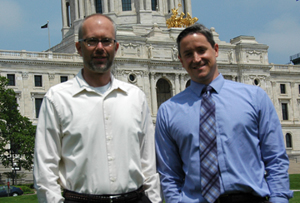
Erik Rudeen and Marc Briese, state legislative liaisons, along with Governement Affairs Director Scott Peterson (not pictured) and other MnDOT staff spent countless hours at the State Capitol lobbying for transportation programs. Photo by Rich Kemp
|
The 2013 legislative session ended with most of MnDOT’s requests enacted, but without a broad increase in transportation funding.
“Although advocates were disappointed in the failure to implement a transportation funding package this year, overall MnDOT was treated quite well by lawmakers,” said Erik Rudeen, Government Affairs.
Below are some of the major highlights.
Transportation Policy
All of the MnDOT agency initiatives were enacted. Some of the provisions include:
- Authorization for a land transfer in each of Le Seuer and Koochiching counties
- Establishment of a joint program office for public-private partnerships
- Several turnbacks of state highways to local governments
- Wider spending authority for ABC parking ramp revenues
- Changes to the logo sign program
- Authority for MnDOT to use emergency relief account funds for maintenance activities by internal forces
- Greater flexibility for the Greater Minnesota Transit account
- Authority to use YIELD signs at passive highway-rail intersections
- Modifications to medical waivers and examinations related to intrastate commercial motor vehicles
Non-MnDOT initiatives that were enacted include a requirement for made-in-Minnesota solar products; permanent establishment of the MnDOT ombudsperson position; and required signing in the cities of Rochester and Anoka.
There was considerable discussion and much support for changes to speed limits. Both the House and Senate versions of the omnibus transportation policy bills included language on speed limits that would have changed the existing statutory 55 mph to 60 mph. However, as a direct result of work by local governments and MnDOT, that provision was not included in the final bill.
Transportation Finance
There was extensive discussion about significant increases in transportation funding for Twin Cities area transit, and highways and bridges statewide. Ultimately, however, no permanent sources of increased funding were enacted. The following provisions were enacted:
- $300 million in trunk highway bonding as a “down payment” for the newly established Corridors of Commerce program, with a promise to pursue additional permanent funding sources in future years. The additional trunk highway bonding puts MnDOT close to the policy limit on bonding, and leaves little flexibility for future bonding.
- Increased funding for MnDOT to account for rising commodity costs.
- $20 million over the biennium for the Transportation Economic Develop (TED) program, all from the Trunk Highway fund. The Governor’s original request was for $20 million from the general fund, which would have provided greater funding flexibility.
- One-time appropriation of $95 million for ADA improvements, the Better Roads program, the Corridor Investment Management Strategy, and other infrastructure needs.
Aviation
There were some major changes to aviation taxes and funding, with widespread support from all aviation interests. The combination of the following aviation-related changes should create a more competitive aviation environment in Minnesota:
- Increase in aviation fuel tax
- Exemptions from sales tax for the purchase and installation of aircraft parts
- Sales tax on aircraft is dedicated to the airports fund
- Decrease in aircraft registration tax
More information about the actions of the 2013 Legislature will be available shortly on the Government Affairs iHUB site. |
 |
|

|
 |
TABLE of CONTENTS
 |
Minnesota, Wisconsin break ground for new St. Croix Crossing |
By Rich Kemp
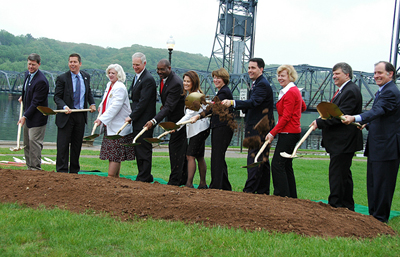
From left, Rep. Ron Kind, Wisconsin; Rep. Sean Duffy, Wisconsin; Mayor Mary McComber, Oak Park Heights; Sen. Ron Johnson, Wisconsin; Derrell Turner, Federal Highway Administration; Rep. Michele Bachmann, Minnesota; Sen. Amy Klobuchar, Minnesota; Wisconsin Gov. Scott Walker; Sen. Tammy Baldwin, Wisconsin; Mayor Ken Harycki, Stillwater; and Commissioner Charlie Zelle break ground for the St. Croix Crossing project during a ceremony May 28. Photo by Rich Kemp
|
The Minnesota and Wisconsin departments of transportation hosted a groundbreaking ceremony for the St. Croix Crossing project May 28 that marks the beginning of construction on the St. Croix Crossing that will connect the two states.
“This is not just a bridge,” said Commissioner Charlie Zelle. “This is a connection between our wonderful two states.”
Speakers at the event, which was held at Lowell Park in Stillwater, were Ken Harycki, Stillwater mayor; Mary McComber, Oak Park Heights mayor; Derrell Turner, Federal Highway Administration; Rep. Sean Duffy and Rep. Ron Kind, Wisconsin; Rep. Michele Bachmann, Minnesota; Wisconsin Governor Scott Walker; Sen. Tammy Baldwin and Sen. Ron Johnson, Wisconsin; and Sen. Amy Klobuchar, Minnesota.
“We are so grateful for Transportation Secretary Ray LaHood and all the backing we had from him,” said Bachmann. “He understands that safety was first and foremost.”
As all the speakers noted, the project has taken many years to come together.
“It took a group of people who were willing to get it done when a lot of people had given up in Washington,” said Klobuchar. “It was truly a team effort.”
This joint project between MnDOT and WisDOT will replace the 80-year-old Stillwater Lift Bridge with a new four-lane bridge to connect expressways on both sides of the St. Croix River. Work includes:
- Realign Hwy 36 and Hwy 95
- Build three-mile, four-lane connection to WIS Hwy 64 from the new bridge
- Construct WIS Hwy 35 overpass, located near the bridge, the WIS Hwy 35/County E interchange and the pedestrian/bike path
- Create extensive trail facilities and preserve historic Stillwater Lift Bridge for use by bikes/pedestrians
- Minimize impacts on the area's historic and natural resources
“This bridge will provide a safer, more reliable crossing,” said Jon Chiglo, MnDOT project director. “It will improve traffic safety and ease congestion in the St. Croix Valley. It will be structurally sound and well-lit for anyone crossing over or under it—including drivers, pedestrians and boaters.”
The total project cost estimate range is from $571 million to $676 million and includes construction, right of way, environmental protection and remediation, contingency, bonds and insurance, engineering and management. MnDOT is the lead agency on this project and is coordinating and sharing costs with WisDOT.
The bridge is scheduled to open in 2016. Visit www.dot.state.mn.us/stcroixcrossing and www.facebook.com/saintcroixcrossingmndot for more information about the project. |
 |
|

|
 |
TABLE of CONTENTS
 |
New Hastings Bridge getting ready for traffic |
|
By Kirsten Klein, Metro District Public Affairs
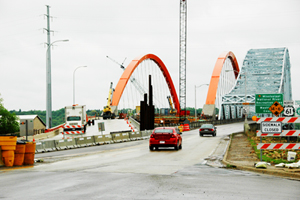
The old and new Hastings Bridges stand side by side. In early June, two lanes of traffic - one lane in each direction - will be routed to the new bridge. Photo by Libby Schultz
|
The bridges in the city of Hastings have always been unique architectural wonders that set the city apart from neighboring communities. Today, commuters are impressed with the city’s engineering prowess by having two bridges side-by-side - one old and one new. The first Hastings Bridge was built in the 1950s and had only two lanes, not enough to support the 30,000 vehicles that travel across the Mississippi River each day. The new bridge features four lanes, has a 100-year lifespan and includes a pedestrian walkway, scenic overlook and public park.
Beginning in early June, two lanes of traffic – one lane in each direction - will be routed to the new bridge. The southbound lanes will be shifted to the new bridge on June 3 and the northbound lanes will be shifted the following day. After both lanes are moved to the new bridge, the old bridge will be removed immediately. It will take approximately one week to remove the portion of the bridge closest to the new bridge. This work must be complete in order to begin the approach for the northbound lanes on the new bridge. The entire removal process will take several weeks.
Community members are eager to have full access to the new bridge and its amenities. In December, when all four lanes of the new Hastings Bridge are open, the bridge will be the longest free-standing tied-arch bridge in North America and it will help improve the safety and mobility along this region.
Follow the progress of the project at: www.dot.state.mn.us/hastingsbridge/. |
 |
|

|
 |
TABLE of CONTENTS
 |
Volunteers picking up trash along highways save state $6 million annually |
By Rich Kemp
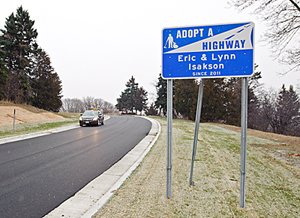
MnDOT will put up a sign with the volunteer group name on the highway where the volunteers will pick up trash. Photo by David Gonzalez |
What motivates people to volunteer to clean up the ditches along Minnesota roadways?
“They volunteer because they really want to keep Minnesota highways beautiful,” said Ernest Lloyd, Adopt a Highway program administrator. “They take pride in what they do.”
The Adopt a Highway program is staffed by volunteers from the public who pick up litter along Minnesota’s highways. It enables the state’s environmentally conscious citizens to make a personal contribution to a cleaner environment—and saves taxpayers millions of dollars.
More than 49,000 volunteers are currently helping to clean up 11,000 miles of Minnesota highways. Adopt a Highway volunteers pick up 26,000 tons of litter per year, which saves MnDOT an estimated $6 million annually.
“Because of the dedication of the Adopt a Highway volunteers, MnDOT is able to spend more time on highway improvement and safety projects,” said Lloyd.
Each district has Adopt a Highway coordinators to help volunteer groups get set up in the program. Darlene Hynding, District 4/Detroit Lakes coordinator, said the volunteers deserve a lot of credit.
“I have heard from people in the community that they are impressed with the job the volunteers are doing to keep the highways clean,” said Hynding. “It is a very good program.”
To become part of the program, the volunteer groups agree to:
- Watch a safety video
- Adopt a two-mile stretch of highway for a minimum of two years
- Pick up litter on both sides of the highway at least twice a year
MnDOT provides safety vests for each volunteer and trash bags for cleanup events. The high-visibility color and the retro-reflective tape help make litter crews more visible to passing motorists.
MnDOT crews pick up the filled bags and large, heavy or hazardous items from the roadside after the group completes its cleanup. State workers, not volunteers, also are responsible for litter pickup along the interstate.
“We appreciate what all these volunteers do,” said Lloyd. “We still have parts of the highways waiting to be adopted and the website is a great tool for interested volunteers.”
For information on the Adopt a Highway program, check out www.dot.state.mn.us/adopt/
|
 |
|

|
|

|
 |
TABLE of CONTENTS
 |
MnDOT achievements, challenges highlighted at research conference |
|
By Nick Busse, Research Services
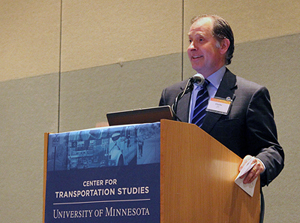
Commissioner Charlie Zelle told CTS Research Conference attendees that research will be critical to building public support for new transportation revenues. Photo by Nick Busse |
MnDOT’s success at reducing roadway fatalities and its future fiscal challenges were among the prominent themes at this year’s Center for Transportation Studies Research Conference.
More than 200 researchers and practitioners from five states gathered in St. Paul May 22-23 for the annual event sponsored by the University of Minnesota. The conference showcases the latest in transportation innovation and technology. Commissioner Charlie Zelle gave the welcoming address at the conference luncheon. He told attendees that research will be key to achieving MnDOT’s long-term vision for a world-class multimodal transportation system.
“We’re going to paint a vision and really kind of start a campaign for our citizens and our legislators to accept and maybe put some more resources into the 20-year plan,” Zelle said. “We have to ground that in some solid arithmetic and some science and research. Without that, it just becomes a lot of words.”
MnDOT staff gave a variety of presentations on subjects ranging from rural road safety to research on mileage-based user fees. Sue Groth, director of the Office of Traffic Safety and Technology, discussed Minnesota’s success in implementing its Toward Zero Deaths program, which she said has dramatically cut the number of fatalities and serious injuries on Minnesota roadways in the last decade.
“We’re doing something right here,” Groth said, noting that Minnesota is among the top three U.S. states for reducing traffic deaths.
MnDOT Planning Engineer Ryan Wilson gave a presentation on the growing gap between Minnesota’s transportation infrastructure needs and its projected revenues. He said that MnDOT’s draft 20-year plan anticipates a $12 billion funding shortfall. Even if the last 10 years of the plan focuses exclusively on asset preservation, Wilson said the state’s transportation infrastructure will still deteriorate without new revenue sources.
CTS expects to have all presentations and other conference materials posted on their website by the first week of June. CTS and MnDOT Research Services also used the occasion to announce the launch of “Crossroads,” their new joint transportation research blog, which can be found at mntransportationresearch.org. |
 |
|

|
 |
TABLE of CONTENTS
 |
Enrollment for Leadership Development Program starts July 1 |
By Carol Hennekens, Office of Human Resources
The next Leadership Development Program is scheduled to begin on Aug. 1. The enrollment period runs July 1-19.
The program will offer new learning opportunities and resources for the participants. Participants set their own leadership goals, create their own development plan, and can participate in three different types of offerings: MnDOT Organizational Knowledge, Leadership Core Skills, and Other Strategies and Resources.
Interested employees should enroll in the 2013-2014 Leadership Development Program if they:
- Want to start their leadership journey
- Want to improve their leadership competencies
- Finished the 2012-2013 program but want to continue with new goals
- Didn’t finish the 2012-2013 program but want to continue
To get started interested employees should review the information on the Leadership Development website to determine if this program is right for them. Then review the steps to enroll.
There will be an article summarizing the first year of the program in the June 12 Newsline.
Contact Carol Hennekens, Leadership Development Program manager, or the LDP team at ldpteam.dot@state.mn.us.
|
 |
|

|
 |
TABLE of CONTENTS
 |
What’s new on the web? |
|
iHub on the iPad
The left tabs on iHub are now iPad friendly. iPad users will be able to open each tab on the left side of iHub and be directed to a new page with links to each option.
Notice something tricky on your iPad? Let the MnDOT web team know!
New Library Materials posted on Web
The April 2013 edition of New Library Materials is now available at http://www.dot.state.mn.us/library/newlibmat.html.
This issue highlights the new digital collection of Minnesota bikeway maps published between 1979 and 2001.
New Library Materials is a compilation of new titles and other resources added to the library collection during the previous month. If you would like to be added to our distribution list, please contact Pam Gonzalez [Pamela.M.Gonzalez@state.mn.us] at 651-366-3749.
Financial Management
Visit the newly revamped financial management iHUB site at ihub/financialmanagement/ to learn more about MnDOT’s current and long-term financial planning, budget, specialized services and accounting systems management. You’ll also find helpful financial resources and contacts.
|
 |
|

|
 |
TABLE of CONTENTS
 |
Lync is coming to your computer this month |
|
By Bob Filipczak
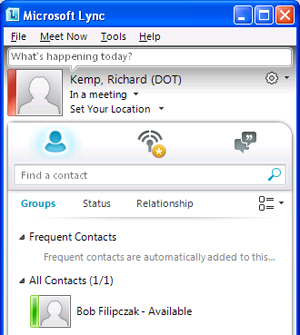
Sample of the Lync home screen with contact list. |
On June 13, a new software tool—Microsoft Lync—will be installed on your computer. After a successful pilot of the program, this instant messaging and online meeting tool will be on the computers of almost all MnDOT employees. With Lync, you will be able improve your communications with your coworkers within your team, across the agency and even across other state agencies.
It’s like a great big software-enhanced group hug.
Ok, maybe not, but it can improve your ability to communicate, and the ripple effects of simply increasing the effectiveness of communication can significantly affect the work you do. So what does Lync do?
Level One—Presence
At its most basic level, Lync can tell you where people are and if they are available. That alone can be a very helpful tool, especially if you prefer to communicate with people face-to-face. You can know, in advance, that Liz is in her office before you walk down there with the document she must sign. It will also tell you if she is tied up in a meeting or away from her office.
Level Two—Instant Messaging
Some messages are too small or require too fast a turnaround for email (and too long to shout over the wall of your cubicle). Instant messaging is ideal for those messages, such as:
- “Hey, is Becky in today? There is a request from Operations that I’ll take if she is out.”
- “I’m heading to Shoreview for the training in 5 if you want to ride along.”
- “Could you email that spreadsheet that Bill showed us?”
Level Three—Video Conferencing
Sometimes you want to connect to people face-to-face, but you don’t want to schedule a formal video or SMART Bridgit conference in one of the dedicated rooms. Lync gives you the power to connect to anyone who has a webcam connected to their computer, giving you both audio and good quality video. It’s informal, instant and allows you to “be there” almost anywhere in the state. If this function allows you to forego one trip to Moorhead or Winona or Ely or Worthington, the camera will pay for itself ($62 for basic webcam and $77 for the higher quality webcam). |
 |
|

|
 |
TABLE of CONTENTS
 |
Dunwoody students check out Cayuga project |
By Rich Kemp
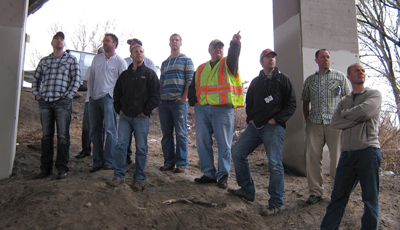
(In safety vest) Barry Nelson, project engineer, gives a tour May 9 to students from Dunwoody College of Technology of the Cayuga project. Photo by Bob Burell |
For construction management students from Dunwoody College of Technology, their field trip on May 9 wasn’t the typical class trip.
The students had the opportunity to see actual contractor operations and project management up close when they visited the site of MnDOT’s Cayuga project, which entails challenging scheduling and coordination with various agency and contractor staff.
The project is located on Interstate 35E between University Avenue and Maryland Avenue in St. Paul. Project work will include a realignment of I-35E, the replacement of the Cayuga and Pennsylvania Avenue bridges along with railroad bridges, construction of retaining and noise walls, and replacement of the existing ramp with a new interchange at Cayuga Street.
Kelly Ness, Dunwoody instructor, reached out to Barry Nelson, MnDOT project engineer, and Bob Burrell, Mendota Resident Office office manager, to have his highway and heavy construction class get a “hands-on” applied learning opportunity. The eight students who participated in this activity are enrolled in a Construction Project Supervision program.
“The site visit was a success,” said Ness. “I hope to visit again with my class next semester.”
The students received information on the overview and scope of the project, bridge construction concepts, a detailed layout plan of the construction, and a plan sheet and section view examples of retaining wall construction. Nelson and Burrell talked to the class about typical contract administration and agency oversight on bid-build projects.
After receiving the information about the project, the students were able to see areas where the construction will take place and witness a sheet pile operation for the construction of a retaining wall.
“The potential talent of the Dunwoody students and their willingness to participate in the Construction Project Supervision program is encouraging to see,” said Burell. “I believe it is a win-win for both public work agencies and contractors.”
Read more about the Cayuga project at www.dot.state.mn.us/metro/projects/35estpaul/cayuga.html. |
 |
|

|
 |
TABLE of CONTENTS
 |
Health and wellness at MnDOT |
By Libby Schultz
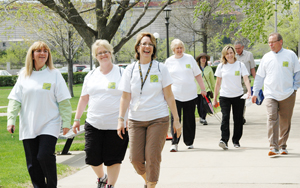
Six of MnDOT's 239 participants in the annual Capitol Walk show off their event T-shirts and walking style at the 12th annual Capitol Walk on May 15. In the foreground, from left, are Brenda Cowin, Jennifer Witt, Deb Ledvina. Behind them are Celine Carpenter, Jeanne Aamodt and Bernie Arseneau. Photo by Libby Schultz |
Wednesday, May 15, marked the 12th annual Capitol Walk aimed at involving Capitol complex employees in the Commuter Challenge.
Bikes were added last year to demonstrate an alternative way to get to meetings in nearby state office buildings.
The Commuter Challenge is a Twin Cities area program that encourages people to use alternate transportation for about two months. The challenge is to take a bus, carpool or bike to work at least once a month.
This year, 444 people (239 were MnDOT employees) walked more than 1,300 laps on the marked course.
“We won the coveted Sock Award,” said Jarvis Keys, transportation specialist, who organizes the challenge for MnDOT.
In the districts
District 4/Detroit Lakes and District 7/Mankato also participated in health and wellness events this spring.
Employees in D4 participated in Bike to Work week and the DLCCC’s Resolution Re-Start Health Challenge. In D7, 30 people participated in a weight loss challenge. They completed challenges to win prizes and tracked progress on an open spreadsheet. |
 |
|

|
 |
TABLE of CONTENTS
 |
Evolving safety strategies during past decade help Minnesota move Toward Zero Deaths |
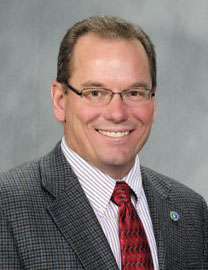
Deputy Commissioner/Chief Engineer Bernie Arseneau.
Photo by David Gonzalez |
Editor’s note: 2013 marks the 10-year anniversary for the Toward Zero Deaths initiative, Minnesota’s cornerstone traffic safety program that integrates the use of engineering, enforcement, emergency medical and trauma services, and education to reduce traffic fatalities and injuries. Bernie Arseneau, deputy commissioner and chief engineer, was involved in establishing the program and remains fully committed to TZD today. Here’s a look at how the initiative—and number of Minnesota traffic fatalities—has changed over time.
By Bernie Arseneau
The start of TZD was rather serendipitous.
The idea of zero road fatalities came about in 2000 or so. MnDOT had been exploring safety options and the idea of a zero target began to be discussed. Sweden had a strategy called Vision Zero aimed at reducing highway fatalities there and some thought it would be an interesting idea for Minnesota to pursue.
In 2003, an opportunity came about for states to participate in the development of state Comprehensive (now Strategic) Highway Safety Plans. MnDOT’s partnership with the Department of Public Safety positioned us well to undertake this initiative that teamed the Federal Highway Administration with the Governor’s Highway Safety Administration. Kathy Swanson, DPS Office of Traffic Safety director; Anne Beers, Minnesota State Patrol chief; and I thought we could benefit from that kind of solution in Minnesota. Kathy and I attended a meeting in Washington, D.C., to kick off this effort, and we were one of 11 pilot states to develop a Comprehensive Highway Safety Plan. It was following this meeting, and as a part of the work developing our CHSP (now SHSP), that we branded our safety program as Toward Zero Deaths. This approach recognizes that, although it will not happen tomorrow, we must aim for zero fatalities on our roads as even one person who leaves home and does not make it back because of a traffic crash, is one too many!
In 2003, there were more than 650 traffic deaths on Minnesota roads. Just nine years later, we reached 388 fatalities, following a low of 368 in 2011. That’s great progress, but it’s still too many people dying on our roadways. Getting to zero is a challenge, but I definitely see us reaching zero through the continued implementation of innovative strategies.
A change in perspective
In order to move Toward Zero Deaths, we had to change our perspective. We shifted from a conversation about fatality rates, and began talking about fatalities. Those people are brothers, sisters, sons, daughters, husbands and wives. We stopped talking about accidents, which is something you can’t prevent, to talking about crashes, which are preventable. We were used to looking for hot spots, where crashes happened. With TZD, we started looking at why they happened.
And because of that change in our perspective, we came up with a completely new set of solutions, like median cable barrier, rumble strips and enhanced pavement markings. We now look at all roads, and we look at systemic solutions. We started giving locals information they wanted and then made it easier and easier for them to implement changes that improve roadway safety in our communities. We brought together the Four E’s (Engineering, Enforcement, Education and Emergency Medical Services) to leverage the synergy that resulted from our varied perspectives. We built the TZD partnership between MnDOT, DPS, the Department of Health, and strengthened our collaborations at the local level, to make zero deaths possible.
A big challenge 10 years ago was convincing others that TZD would reduce death and injury on Minnesota roads. Now it’s a brand that’s been adopted nationally. A lot of people think zero is an unreasonable goal, but I think it’s going to happen in our lifetime. And technology is going to help get us there.
This month, the White House recognized our leadership using technology to provide real-time information at rural intersections. Our rural intersection conflict warning system uses sensors and flashing lights to let motorists know about other traffic. That might look like a small thing to someone else, but that use of technology is a big thing. And it’s going to help us get closer to zero deaths.
The closer we get to zero, the harder it is to keep that ball rolling toward zero. We’ve got to work harder and harder to reach our zero goal. Now that fatality numbers are leveling off, this work needs more attention.
I believe in what we are achieving with Toward Zero Deaths. Many people will never know the effect that the TZD program and its safety strategies have had on their lives—and their ability to make it home safely. As a public servant, I believe it’s an incredible honor to have a small part in impacting lives in a positive way. I think that’s pretty remarkable, and I’m glad to be a part of it. |
 |
|
| |
|



